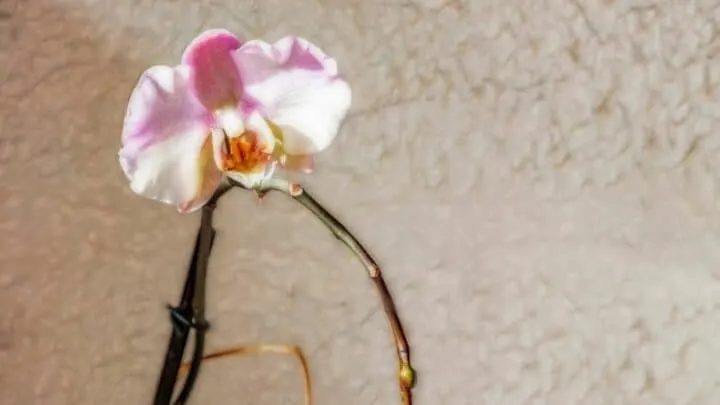Orchids are lovely, and buying enough to fill your home and give for gifts can be cost-prohibitive. However, growing new plants from those you have is possible with some varieties of orchids.
Some types of orchids can be grown using stem cuttings to start a new orchid. Rooting a new plant from stem cutting is the easiest method you can try out.
Note that we are speaking of stem cuttings that have leaf nodes, not the flower spike.
Learning the parts of your orchid will help you know how to care for its needs. Each cultivar has its own needs, and understanding them is part of the journey of growing orchids.
Read on for how to grow an orchid from a stem.
How to Grow an Orchid from a Stem
In a tray that’s 2-3 inches deep (5-7.6cm), layer it with pebbles, gravel, or other coarse material for drainage. Add dampened sphagnum moss, sand, fir bark, or a mix of these 3, soak it, and let it drain before placing it in the tray. Cut a 10-inch long section of the stem. Dress the open ends with an antifungal, covering them loosely with a film wrap before placing them in a warm place.
Gather your Materials
Before beginning this project, you will need a few things that will make your venture more successful.
You don’t need to buy the tray that you use for rooting. It may already be in your kitchen disguised as a cake or roasting pan.
You may also have the other ingredients necessary to develop a plant from a stem if you are already growing orchids.
For example, many growers use fir bark and sphagnum moss as plant mediums for their orchids, and you may, also. If so, then you have what you need to root your stem cutting.
As for drainage materials, if you don’t have pebbles or gravel, other course mediums will work. Think marbles, plant pearls, or clay pebbles.
The substrate doesn’t matter as long as it is not toxic and facilitates drainage for your plant cuttings. If your stem cuttings get too wet, all you will get from your efforts is a soggy, dead plant stem.
Some growers recommend dressing the area of the stem you have cut with an anti-fungal or growth hormone, while others omit this step.
You can try both methods and see which works with your style.
How to Cut an Orchid Stem
How you cut the stem for rooting your orchid is important, and so is the tool you use to cut it with.
Whether you use a knife or pruning shears, sanitize the blade with alcohol before the first cut and each subsequent cut.
After cutting the main large stem section, sanitize your cutting tool, and cut the stem into two to four-inch sections between leaf nodes.
It is at this point you add anti-fungal and growth hormones to your cuttings.
Prepare the Stem for Rooting
You have your cuttings, and they are prepared, so now you place them in the rooting tray, spritz them with water, cover with a loose-fitting piece of plastic film, and place them in a warm dark location.
The orchid stems need to be kept at a temperature between 75 and 85 degrees Fahrenheit and given a spritz of water, moistening the cuttings but not making them soaking wet.
Liquid water-soluble fertilizer can be applied every couple of weeks to help your plants along as they grow.
Add the fertilizer to your spritzer water, and apply as you would for your regular watering routine. The process of growing roots and new leaf shoots will take several weeks, so be patient.
If any of the stems get soggy or show signs of rot, remove and discard them.
What to do When Orchid Roots Appear
After a few weeks, you should begin to see the beginning of roots, and then a bit later, the start of shoots.
Once the roots and the cutting shoots are about two inches long, prepare a two-inch pot with a drain hole for your plant to continue its growth cycle.
The pot needs to be filled with a bit of substrate in the bottom for drainage and some dampened sphagnum moss, mixed with a bit of fir bark.
Plant the rooted stem with the upright and the new shoot facing up or to the side and not covered with plant medium.
If you need to, support your new orchid with a small stake, careful not to interfere with its tender little roots.
Place your baby orchids in a room with indirect sunlight and mist them regularly. Orchids like the sun, but the direct sun can burn their leaves, place them in a window with a lot of diffused sunshine.
In short, your orchids will grow into beauties that you can add to your collection of orchids and give to friends.
Frequently Asked Questions about How to Grow an Orchid from a Stem
Is growing an orchid from a stem hard to do?
It depends on the orchid type you are trying to root. New growers of orchids will have their best luck with a dendrobium variety of orchids. Many people have started these plants successfully using stem cuttings.

Daniel has been a plant enthusiast for over 20 years. He owns hundreds of houseplants and prepares for the chili growing seasons yearly with great anticipation. His favorite plants are plant species in the Araceae family, such as Monstera, Philodendron, and Anthurium. He also loves gardening and is growing hot peppers, tomatoes, and many more vegetables.


